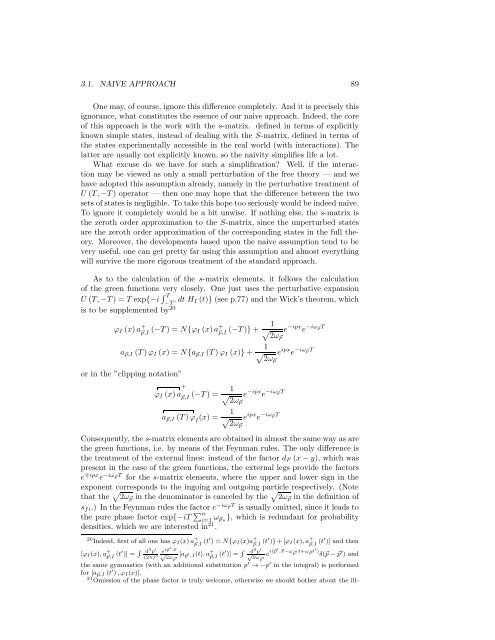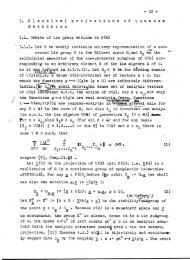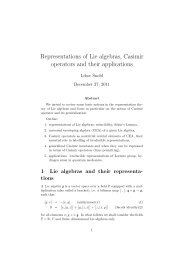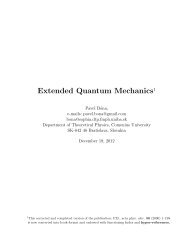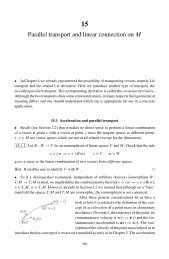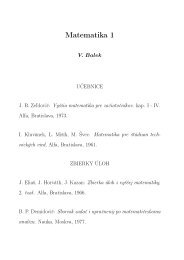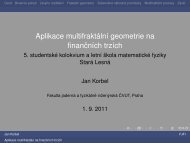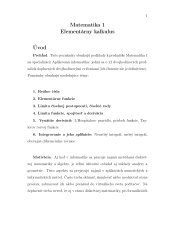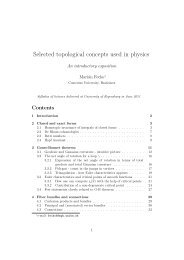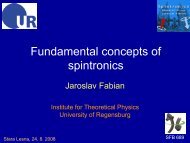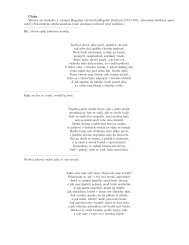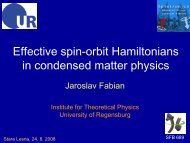Quantum Field Theory I
Quantum Field Theory I
Quantum Field Theory I
Create successful ePaper yourself
Turn your PDF publications into a flip-book with our unique Google optimized e-Paper software.
3.1. NAIVE APPROACH 89<br />
One may, of course, ignore this difference completely. And it is precisely this<br />
ignorance, what constitutes the essence of our naive approach. Indeed, the core<br />
of this approach is the work with the s-matrix. defined in terms of explicitly<br />
known simple states, instead of dealing with the S-matrix, defined in terms of<br />
the states experimentally accessible in the real world (with interactions). The<br />
latter are usually not explicitly known, so the naivity simplifies life a lot.<br />
What excuse do we have for such a simplification Well, if the interaction<br />
may be viewed as only a small perturbation of the free theory — and we<br />
have adopted this assumption already, namely in the perturbative treatment of<br />
U (T,−T) operator — then one may hope that the difference between the two<br />
sets ofstatesis negligible. Totakethis hopetooseriouslywouldbe indeed naive.<br />
To ignore it completely would be a bit unwise. If nothing else, the s-matrix is<br />
the zeroth order approximation to the S-matrix, since the unperturbed states<br />
are the zeroth order approximation of the corresponding states in the full theory.<br />
Moreover, the developments based upon the naive assumption tend to be<br />
very useful, one can get pretty far using this assumption and almost everything<br />
will survive the more rigorous treatment of the standard approach.<br />
As to the calculation of the s-matrix elements, it follows the calculation<br />
of the green functions very closely. One just uses the perturbative expansion<br />
U (T,−T) = T exp{−i ∫ T<br />
−T<br />
dt H ′ I (t)} (see p.77) and the Wick’s theorem, which<br />
is to be supplemented by 20<br />
ϕ I (x)a + ⃗p,I (−T) = N{ϕ I (x)a + ⃗p,I (−T)}+ 1 √<br />
2ω⃗p<br />
e −ipx e −iω ⃗pT<br />
a ⃗p,I (T)ϕ I (x) = N{a ⃗p,I (T)ϕ I (x)}+ 1 √<br />
2ω⃗p<br />
e ipx e −iω ⃗pT<br />
or in the ”clipping notation”<br />
+<br />
ϕ I (x)a⃗p,I (−T) = √ 1 e −ipx e −iω ⃗pT<br />
2ω⃗p<br />
a ⃗p,I (T)ϕ I<br />
(x) = 1 √<br />
2ω⃗p<br />
e ipx e −iω ⃗pT<br />
Consequently, the s-matrix elements are obtained in almost the same way as are<br />
the green functions, i.e. by means of the Feynman rules. The only difference is<br />
the treatment of the external lines: instead of the factor d F (x−y), which was<br />
present in the case of the green functions, the external legs provide the factors<br />
e ∓ipx e −iω⃗pT for the s-matrix elements, where the upper and lower sign in the<br />
exponent corresponds to the ingoing and outgoing particle respectively. (Note<br />
that the √ 2ω ⃗p in the denominator is canceled by the √ 2ω ⃗p in the definition of<br />
s fi .) In the Feynman rules the factor e −iω⃗pT is usually omitted, since it leads to<br />
the pure phase factor exp{−iT ∑ n<br />
i=1 ω ⃗p n<br />
}, which is redundant for probability<br />
densities, which we are interested in 21 .<br />
20 Indeed, first of all one has ϕ I (x)a + ⃗p,I (t′ ) = N{ϕ I (x)a + ⃗p,I (t′ )}+[ϕ I (x),a + ⃗p,I (t′ )] and then<br />
[ϕ I (x),a + ⃗p,I (t′ )] = ∫ d 3 p ′<br />
(2π) 3 e i⃗p′ .⃗x<br />
√<br />
2ω⃗p ′ [a ⃗p ′ ,I(t),a + ⃗p,I (t′ )] = ∫ d 3 p ′<br />
√<br />
2ω⃗p ′ ei(⃗p′ .⃗x−ω ⃗p ′t+ω ⃗p t ′ ) δ(⃗p − ⃗p ′ ) and<br />
the same gymnastics (with an additional substitution p ′ → −p ′ in the integral) is performed<br />
for [a ⃗p,I (t ′ ),ϕ I (x)].<br />
21 Omission of the phase factor is truly welcome, otherwise we should bother about the ill-


